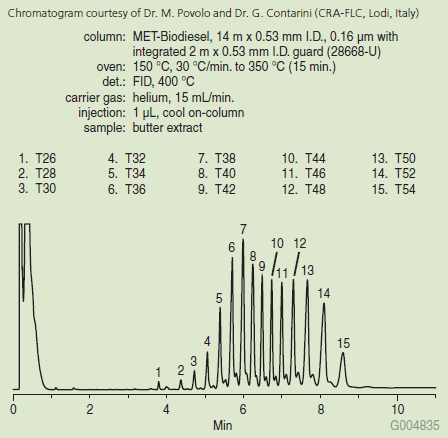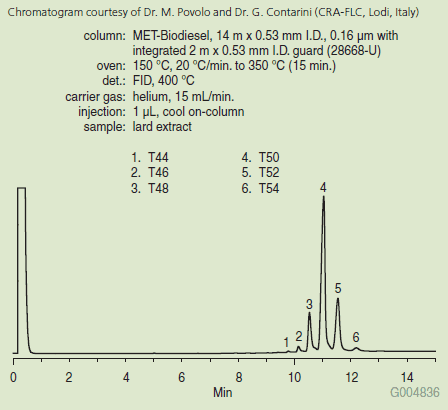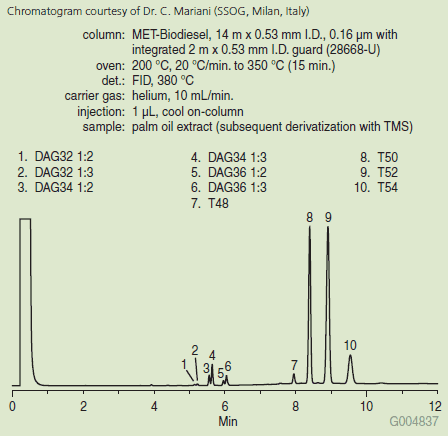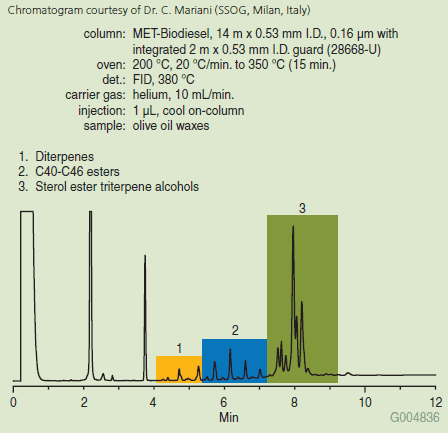Determination of Triglycerides and Waxes in Food Products Using Cool On-Column Injection and the MET-Biodiesel Capillary Column
Introduction
Food nutrition (composition, fat content, labeling requirements, etc.) and food chemistry (ingredients, purity, flavors & fragrances, etc.) are two areas of study in a food & beverage laboratory. Examples of each are:
- Desired nutritional data includes the triglyceride content of various food products, providing information that complements that of the fatty acid composition
- Food chemistry analysis includes the characterization of wax content in olive oil, used to help ensure the product is unadulterated
Both of these analyses can be accomplished with the use of capillary gas chromatography (GC). The suitability of the MET-Biodiesel capillary column to perform both of these applications was investigated.
MET-Biodiesel Column
The Supelco MET-Biodiesel capillary GC column was designed specifically for the determination of free and total glycerin in B100 biodiesel samples. Table 1 lists the column specifications. Several features and benefits of this column indicate that it is also well-suited for the analysis of triglycerides and waxes in food products. These features and benefits include:
- Metal column holds up better than fused silica, virtually eliminating column breakage
- Integrated guard protects the analytical column, extending column life with a leak-free connection
- Integrated guard also acts as a retention gap, minimizing peak broadening
- Provides good peak shape and resolution for glycerides
- Able to separate mono-, di-, and triglycerides (the mono- and diglycerides analyzed as TMS derivatives)
- Short column length, allowing for fast analysis times
- Operates at a maximum temperature of 380 °C (isothermal) and 430 °C (programmed)
Our goal was to obtain the acceptable resolution in as fast of run time as possible. Several analyses, each using a different mix, were performed to illustrate the chromatographic results that can be obtained with this column. All separations were performed using cool on-column injection, which improves the recovery of high molecular weight substances.
Triglycerides
Triglycerides (also called triacylglycerol, triacylglyceride, or TAG) are the main constituent of vegetable oil and animal fat and make up most of the fats digested by humans. They are important in that they allow the uptake and transport of fat-soluble vitamins. Plus, they play a role in metabolism (unused saturated or monounsaturated fatty acids are stored by the body as triglycerides). However, triglyceride intake should be monitored because high levels of triglycerides have been linked to an increased risk of heart disease and stroke.
Most natural fats contain a complex mixture of individual triglycerides. Therefore, efficient capillary columns with the ability to provide ample resolution are required for proper identification. Triglycerides are large compounds requiring a relatively high final oven temperature for elution in a reasonable time.
Triglycerides in Butter and Lard
The extraction and analysis of triglycerides in butter and lard samples were performed, with the resulting chromatograms shown in Figure 1 and Figure 2, respectively. Peak IDs follow the nomenclature that T## (Triglyceride Number or Triacylglycerol Number) signifies the total number of carbons on the fatty acid chains, regardless of the degree of saturation or position on the glycerol backbone. For example, T54 could be SSS, a triglyceride containing three stearic acids (C18:0). It could also be SOS or SSO, a triglyceride containing two stearic acids (C18:0) and one oleic acid (C18:1).

Figure 1.Butter Triglycerides (28668-U)

Figure 2.Lard Triglycerides (28668-U)
The MET-Biodiesel, in combination with cool on-column injection, fast carrier gas flow rates, rapid oven temperature ramp rates, and high final oven temperatures, was able to provide significant resolution for both applications with relatively short run times. As evident, the triglyceride profile of butter is much more complex than that of lard. The profile differences can be attributed to the fact that these products are from different sources; butter is processed from cow milk or cream whereas lard is rendered from pig fatty tissues.
Glycerides in Palm Oil
The mono-, di-, and triglyceride composition of vegetable oils can be used as a measurement of quality and purity. If the oil is adulterated with inferior oil, the peak patterns and/or ratios will not match up to historical data, potentially falling outside of acceptable control limits.
Because mono- and diglycerides have active hydroxyl functional groups, they must be derivatized prior to analysis to minimize analyte adsorption, thereby reducing peak tailing. An extract of palm oil was analyzed on the MET-Biodiesel after the mono- and diglycerides were converted to TMS-derivatives. As shown in Figure 3, the di- and triglycerides were separated with no overlap between groups. Additionally, the peak shape of the triglycerides is an indication of good column inertness.

Figure 3.Palm Oil Glycerides (28668-U)
Triglyceride peak ID nomenclature is the same as discussed earlier. Diglyceride peak IDs follow the nomenclature that DAG## (Diacylglycerol Number) signifies the total number of carbons on the fatty acid chains, regardless of degree of saturation. The 1:2 and 1:3 then designate the position of the fatty acid substitution on the glycerol. For example, DAG36 1:2 has fatty acids at both the first and second positions on the glycerol backbone whereas DAG36 1:3 has fatty acids at both the first and third positions.
Olive Oil
Olive oil is rich in monounsaturated fats, most notably oleic acid. This is of interest because a diet with a higher proportion of monounsaturated fats is linked to a reduction in the risk of coronary heart disease, due to favorable effects on cholesterol regulation and LDL cholesterol oxidation, as well as helping to build a more healthy balance between omega 3 and omega 6 fats. Therefore, it is desirable to substitute olive oil for other food products wherever possible.
Olive oil is used throughout the world, especially in the countries surrounding the Mediterranean Sea. The quality of the olive oil, influenced by the source of the olives and also how it is processed, determines what it can best be used for. Possible uses for various grades of olive oils are shown in Table 2.
Olive oil is regulated in much of the world to discourage the labeling of lower grade oils as higher-grade oils. As such, detailed analytical work is performed to fully characterize the oil. This may include the determination of free fatty acids, peroxide index, wax content, sterol content, erythrodiol and uvaol, saturated fatty acids in position 2 of the triglyceride, spectrophotometric analysis, fatty acid composition, volatile halogenated solvents, organoleptic characteristics, stigmastadienes, triglyceride content, and aliphatic alcohol content.
Olive Oil Waxes
One of the regulated characteristics of olive oil is its wax content, an indicator of both quality and purity. Because wax content varies among the various categories of edible oils, comparing peak patterns and ratios to known references and specifications can determine if the olive oil has been adulterated with inferior oil.
Because some of these wax compounds may have high boiling points, GC analysis using a column with a high-temperature limit is desirable. This allows for elution of all analytes in a reasonable amount of time with good peak shape. Figure 4 shows the chromatogram obtained from the analysis of olive oil on the MET-Biodiesel column. The use of a 350 °C final oven temperature helps to produce sharp peaks, allowing for easy and accurate peak pattern and ratio comparisons to known references.

Figure 4.Olive Oil Waxes (28668-U)
Conclusions
The MET-Biodiesel capillary column is a suitable choice for analysts who work on triglyceride and/or wax separations in which high column temperatures are required. The column’s inertness, high thermal stability, and low bleed ensure good peak shape and resolution for the analytes that were evaluated. As shown, this column can be used to achieve optimal result for these applications.
Materials
References
To continue reading please sign in or create an account.
Don't Have An Account?